#fred hagstrom
Explore tagged Tumblr posts
Photo

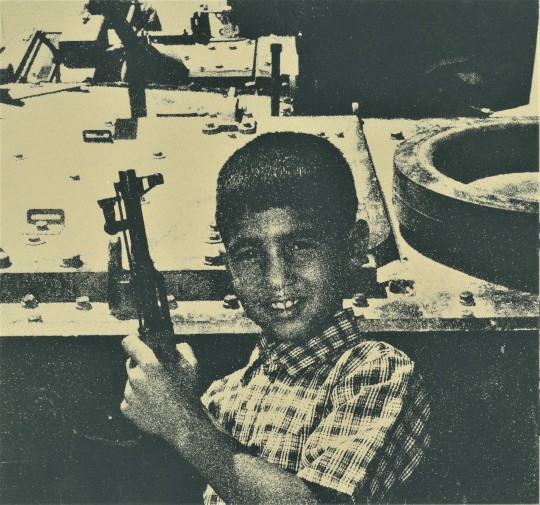
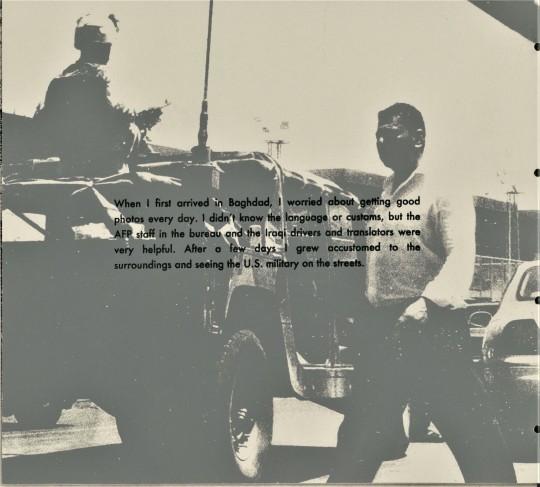
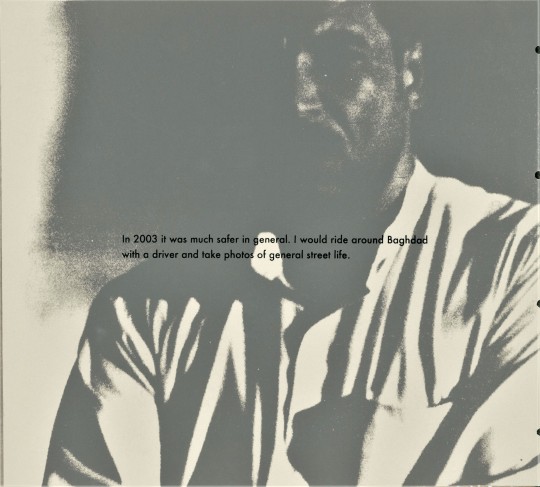

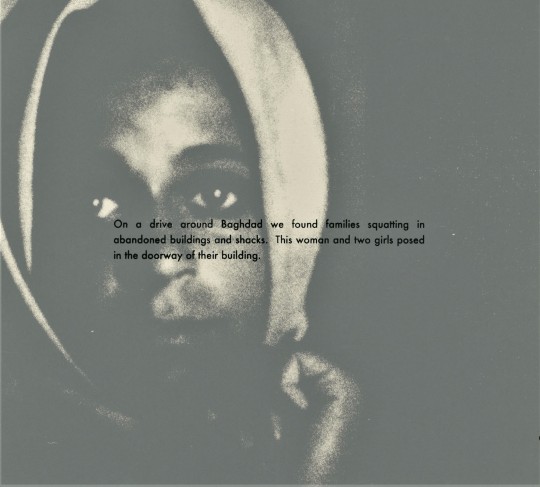

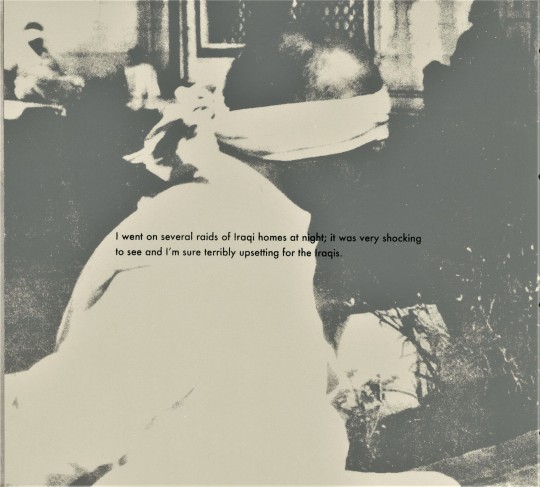
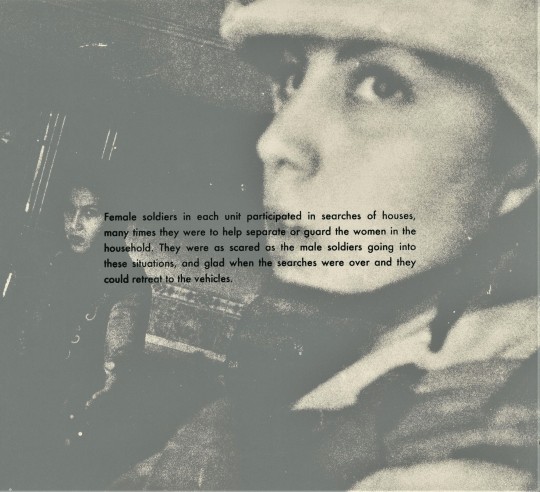

It’s Fine Press Friday!
Stan Honda is a notable New York-based Asian American photojournalist who has worked for several publications, especially Agence France-Presse. In 2011, he collaborated with Minnesota printmaker and book artist Fred Hagstrom to produce this artists book, When I First Arrived in Baghdad, from Hagstrom’s Strong Silent Type Press in a limited edition of 35 copies signed by the artist/printer. Hagstrom silkscreened Honda’s images and reflections from his assignments in Iraq, and bound them between printed metal covers using a wire-edge binding. The font is Futura. Fred Hagstrom writes:
I first contacted Stan Honda . . . in the days after September 11th. He took some of the most moving photographs of that day, including some of business people shrouded in dust and trying to get home after the collapse of the towers. These have become some of the most iconic images of that day. I was struck by the human qualities in his photos and invited him to speak at my school. We stayed in touch, and I have seen that same quality in much of his later work, including his photos from the gulf after Katrina, and from two trips to Iraq. He seems to always have a sense for bringing out the human part of these stories. For this book, I asked him to give me a selection of his Iraq photos and to respond to a brief sort of interview for me to generate the text. I then printed the photos in silk-screen, pairing them with his words. Together they do the best of journalism: a human perspective on a complicated moment in history.
View other posts of books by Fred Hagstrom.
View more Fine Press Friday posts.

#Fine Press Friday#Fine Press Fridays#Asian American and Pacific Islander Heritage Month#AAPI Heritage Month#Stan Honda#photojournalists#Iraq#Iraqi War#Asian Americans#photographers#fred hagstrom#strong silent type press#fine press books#artists books#Minnesota artists#silkscreen printing#Futura#wire-edge binding
16 notes
·
View notes
Text

Fred Hagstrom "Dark Tree" 2018, intaglio monoprint, 13 x 10".
Minnesota artist Fred Hagstrom received his BA from Hamline University in St. Paul, MN and his MFA from the University of Nebraska-Lincoln. In addition, he studied at the University of Chicago for one year, as well as under S.W. Hayter at Atelier 17 in Paris, France. Hagstrom takes student groups to Australia, New Zealand and the Cook Islands. Studying the art of that region and drawing in nature during those trips has been influential in his work. He has been teaching printmaking at Carleton College since 1984. His prints and artist’s books are included in numerous public collections. Hagstrom lives and maintains a studio in St. Paul.
13 notes
·
View notes
Photo









#ArtsyFriday
“And I am dumb to tell a weather's wind How time has ticked a heaven round the stars.”
--Dylan Thomas
Forces and Fossils marries poetry from Dylan Thomas with 19th century taxonomical illustrations from Ernst Haeckel through imaginative screenprints from artist Fred Hagstrom. This drum leaf bound artists’ book was created in 2011 by Hagstrom and Strong Silent Type Press in Northfield Minnesota in a run of 20; our library copy is number 16. Dylan Thomas’s “The Force that Through the Green Fuse Drives the Flower” was published in The Poems of Dylan Thomas in 1939. Ernst Haeckel’s 1862 Radiolaria contributed to the identification of these small sea creatures whose remains of intricate mineral skeletons are found on the ocean floor and as micro-fossils. The poem, illustrations, and book can be framed as both force and fossil as we are left to marvel at the imprints of the past.
--Laura
x-Collection FOLIO N7433.4 .H25 F67 2011

#artsyfriday#forces and fossils#artists' book#university of iowa#special collections#Fred Hagstrom#screenprint#drum leaf book#radiolaria#fossils#dylan thomas#beautiful books#Strong Silent Type Press
67 notes
·
View notes
Text
RECENT ACQUISITIONS
Book Arts and Fine Press Collection
Throughout the pandemic, Special Collections has continued to support local artists through purchases for the library’s Book Arts and Fine Press Collection. Our catalogers are getting caught up on all those purchases. Here's a selection from our latest batch, with numerous purchases from the following artists. Click the artists' names to see all their work and learn more about each piece.
María José Castillo


Fred Hagstrom


C.B. Sherlock


Camilo Aguirre


Browse more of the Book Arts and Fine Press Collection in the Hennepin County Library online catalog. The books are available to view in-person at the Minneapolis Central Library.
#Book Arts and Fine Press Collection#Minneapolis#Minnesota#book artists#artists' books#book arts#artist books
35 notes
·
View notes
Text
The list of artists that I share with students in assignments, host as visiting artists is diverse. The push that many instructors experienced this year to decolonize their syllabi, I did not experience in the same way. Though I did re-interrogate my syllabi. With a course like Representing Blackness, it is more important to substantially foreground Black artists like multimedia artist and printmaker Daniel Minter of Indigo Arts Alliance or papercut artist Janelle Washington or printmaker and founding member of Black Women of Print Delita Martin, but also to allow students to look at how they present themselves and their communities versus how their white counterparts represent Blackness. If we are discussing my Harvest: Holding & Trading (2013), then we should also examine artists’ books on slavery by book artists such as Maureen Cummins’ The Business is Suffering or Fred Hagstrom’s Little Book of Slavery (2012). If we are examining, Clarissa Sligh’s It Wasn’t Little Rock (2004), then we should be interrogating work by white artists about the civil rights era such as Clifton Meador’s Long Slow March (1996) or Jessica Peterson’s Unbound (2014) or Cause and Effect(2009). While I am more interested in what a Black artist says about their experience, culture, history, I think it is valuable to see how their approach or connection to the subject matter contributes or does not contribute to the artwork. Is there a care and respect that they bring to the work that a white artist cannot? Why are they making this work? I think it is an important conversation to have within my classes and with my research.
I typically build into my artists’ book project an aspect that pushes me to work with a technique in which I need to build mastery or for some reason I’ve avoided. It’s baked into each project, and not something that is necessary for the reader/viewer to know.
https://artistsbookreviews.com/2020/12/26/interview-with-tia-blassingame-part-1-of-2/
https://artistsbookreviews.com/2020/12/27/interview-with-tia-blassingame-part-2-of-2/
2 notes
·
View notes
Photo

Fred Hagstrom, Sister, Common Sense Graphics, 1993 http://ift.tt/2gO87Bm
6 notes
·
View notes
Photo



Our rare books display case saw extra traffic today, as part of the Founders Day scavenger hunt decathlon #wefoundmac. A question students had to answer related to the Lexicon Series by the Institute for Anarchist Studies (IAS). On display are: “White Supremacy” by Joel Olson, “Colonialism” by Maia Ramnath, “Power” by Todd May, and “Gender” by Jamie Heckert.
Also seen at top are Deeply Honored by Fred Hagstrom (left) and We Are Here by Rose Holdorf.
16 notes
·
View notes
Photo










Spotlight: Fred Hagstrom
On this lovely Monday afternoon, we’ve decided to highlight Minnesota printmaker and book artist Fred Hagstrom with the collection “So Many Many Many”, which he designed and contributed imagery for. It contains the poem “Dreamlessly” by Charles Bukowski and additional images contributed by English/Australian artist Graham Fransella ,with printing assistance from Molly Kent. The text was printed letterpress from polymer plates on BFK Rives paper Hagstom’s Strong Silent Type Press in Minnesota in 2005 in an edition of twenty. The ten intaglio images are split evenly between the artists, with Hagstrom’s presented in three colors and Fransella’s in two. The edition is bound in maroon cloth with one of Fransella’s images on the front cover.
The poetry in this collection carries a palpable melancholia as Bukowski details the sadness he encounters as a passerby, matched by images that firmly place the reader on the outside of the narrative. The images mainly include unidentifiable characters disassociated from the viewer, but also watching, casting them as the lonely others that Bukowski describes. Fransella’s image on the cover, for example, shows three shadows appearing to stand over the reader as if to wake them up from a dream, firmly situating us as the sad object of the content. Although the images have quite different styles, with Fransella’s utilizing deep line etchings to create textured images and Hagstrom’s use of solid color blocking to create characters against colored backgrounds, they marry well together as they precede each poetic stanza. This choice sets the narrative structure for the book and allows the imagery to inform the reader before encountering the poetry. The narrative thrust is typical of Bukowski’s work; witnessing the drudgery of everyday American life as an outsider. The images evoke two very different perspectives: one, a sense of being watched and two, the sensation of mundane confusion, altering the poetic import from banal observation to a feeling of trespassing.
View more posts about Fred Hagstrom’ s work.
-Emily, Special Collections Writing Intern
#Spotlight#fred hagstrom#Graham Fransella#intaglio#charles bukowski#strong silent type press#bfkrives#So Many Many#Dreamlessly#Molly Kent#poetry#artists books#letterpress printing#emily birz
32 notes
·
View notes
Photo










Staff Pick of the Week
Last week, UWM Special Collections hosted a Creative Nonfiction class and one of the books we pulled for students to look at was the artist book Deeply Honored by Fred Hagstrom, printed in 2010 in Northfield Minnesota for his Strong Silent Type Press in an edition of 25 copies.
I was initially drawn to Deeply Honored because I love screen-printing and was intrigued by the color choices Hagstrom made in reproducing historical photographs. The book is quite moving and tells the story of the internment of Japanese Americans in the United States during World War II. Carleton College located in Northfield, Minnesota participated in the efforts of the Student Relocation Council which offered scholarships to Japanese American students so they could leave the camps and pursue their educations. Frank Masao Shigemura was the first of twelve students to come to Carleton during the war. Frank Shigemura spent one year at Carleton and fully immersed himself in student life and was a member of the swim team. He felt a call to serve his country and joined the Army Enlisted Reserve, but was rejected for service because of his ancestry even though he was born in the United States. The dean of Carleton College, Lindsey Blayney, began writing letters on Frank’s behalf, attesting to his character and sense of patriotism.
Frank Shigemura served in the 442nd Regimental Combat Team and participated in the liberation of “The Lost Battalion.” He was killed in France on October 20, 1944. He was 23 years old. Carleton College published a “Gold Star” booklet as a memorial for the 54 Carleton men killed in the war. In response to the booklet, Frank’s parents Mr. and Mrs. Shigemura sent a letter expressing their gratitude to the school, writing:
“We deeply feel honored in having Frank's picture in a memorial booklet honoring Carleton College gold star men. It is hard to realize that Frank will never return. I can only say that I am thankful that he was able to serve his country, God and us all. I shall always be proud to be the mother of a true American. Frank has often mentioned in his letters about the fair treatment and kindness he received from both the faculty and the students of Carleton College. I cannot find words adequate enough to fully express our thanks. We are ever and ever so grateful to you all."
Included with the letter was a financial contribution to the school, one of many that would follow in the coming years despite the Shigemuras limited income. The school tried to dissuade them from sending money but the Shigemuras continued to, citing their appreciation of the school in preserving Frank’s memory. Carleton College established a Frank Shigemura Scholarship and eventually created a room in his honor in the Willis Memorial Hall. Frank’s parents Takejuro and Kaye Shigemura felt a connection to the Carleton for the rest of their lives and left their estate to school. Deeply Honored was designed and printed by Fred Hagstrom. The images and letters featured in the book are from the Densho Archive and the Carleton College Archives.
UWM Special Collections holds a number of Fred Hagstrom’s books. View more of our Tumblr posts about his work here.
–Sarah, Special Collections Graduate Intern
#Staff Pick of the Week#Deeply Honored#Fred Hagstrom#Strong Silent Type Press#Carleton College#Frank Masao Shigemura#Student Relocation Council#Japanese internment#442nd Regimental Combat Team#Densho Archive#Carleton College Archives#silk screen printing#silk screen prints#silkscreen#Japanese history#Japanese American#artist books#book arts#Sarah Finn#sarah
22 notes
·
View notes
Photo






RECENT ACQUISITIONS Artists’ Books: 1918 and Covid 2020
Throughout this strange year, we’ve continued to support local artists through purchases for the library’s Book Arts and Fine Press Collection. Two new acquisitions stand out as notable works representing our time and place: Covid 2020 by photographer Laura Migliorino and 1918 by printmaker Fred Hagstrom (Strong Silent Type Press).
Covid 2020 features photographs primarily of the Minneapolis North Loop neighborhood during the early months of Covid-19. We see shuttered doors, empty highways, and a few signs of hope.
1918 includes statistics and personal letters from the 1918 Spanish Flu, along with images from that pandemic which killed 650,000 people in the United States. The images and messages from over 100 years ago eerily relate to today’s pandemic. Fred notes in the colophon that the book was “printed in a socially distanced time with no assistants.”
Due to Covid-19, Hennepin County Library services are reduced. These two artists’ books have not yet been cataloged and are currently unavailable to view physically in the Special Collections department. In the meantime, Special Collections staff are happy to assist with your remote reference needs. Email [email protected].
#artists' books#Covid-19#1918 flu#pandemics#book arts#book arts and fine press collection#book artists
43 notes
·
View notes
Photo










3-Day, Hands-on, Pop-up Exhibit for National Poetry Month
April may be the cruelest month, breeding lilacs out of the dead land, mixing memory and desire, stirring dull roots with spring rain, but it is also National Poetry Month and that's something to celebrate!
So, in celebration Special Collections is holding a 3-day, hands-on, pop-up exhibition on Poetry in Early and Special Editions April 24-26 Works visitors may peruse and handle include:
Printings of Geoffrey Chaucer's Canterbury Tales, including a leaf from the very first printing by William Caxton (1476); a stunning facsimile of the Kelmscott Chaucer of 1896; and two famous fine-press printings of the Prologue: the 1975 Plantin Press modern-English edition, and the 1978 Circle Press edition with original screen prints by Ron King.
The massive, 1923 Ashendene Press edition of Edmund Spenser's Faerie Queene, with the press's Subiaco type designed by William Morris and Emery Walker and calligraphic capitals by Graily Hewitt.
The first illustrated edition of John Milton's Paradise Lost, 1688, along with the magnificent Golden Cockerel Press edition of 1931, with original typography by Eric Gill and original wood engravings by Mary Groom.
The rare third edition of Walt Whitman's Leaves of Grass (1860), as well as American poet William Everson's Lime Kiln Press edition of Whitman's American Bard (1981), and the Welsh press Gwasg Gregynog's fine-press printing of Wrenching Times, poems from Whitman's Drum Taps, printed in 1991 with original color-wood engravings by Minnesota/Wisconsin artist Gaylord Schanilec.
Fred Hagstrom's Strong Silent Type Press artist's-book editions of poems by W. B Yeats, Dylan Thomas, and Charles Bukowski.
Original literary manuscripts from the papers of Milwaukee poet and scholar Martin Jack Rosenblum and the Records of The Little Review.
Piles of poetry by poets in areas we specialize in: UWM, Native American, Irish, and Latinx/Latin American, and much more!
In Wisconsin, It may not seem quite like spring yet, but the force that through the green fuse drives the flower drives my green age . . . and I am dumb to tell the crooked rose my youth is bent by the same wintry fever.
Click on images for details.
Special Collections is open 10 am to 5 pm. Our pop-up exhibition will begin at 2 pm on Wednesday April 24 and end at 5 pm on Friday, April 26. This event is free and open to the public.
34 notes
·
View notes
Photo








It’s Fine Press Friday!
This week we present Fred Hagstrom’s award-winning artist's book Passage. Perhaps not technically a fine-press book (i.e., the entire book is silkscreened rather than letterpress printed), Passage is still a beautiful deluxe work produced in the spirit of that tradition. The book, signed and numbered by the artist, was silkscreened on Rives paper in an edition of 22 in a drum-leaf binding for Hagstrom's Strong Silent Type Press in 2013.
Passage is an artistic examination of the cruelty of the slave trade. Known for his juxtaposition of historical texts and archival imagery, Hagstrom combined material from two significant works that contributed to the building of opposition to the slave trade: diagrams of slaving ships from An Essay on the Impolicy of the African Slave Trade by Thomas Clarkson (1788), and text and images from Biographical Sketches and Interesting Anecdotes of Person of Color by Abigail Mott (1837). For the abolitionists, the images of transport conditions for slaves during the Middle Passage as represented by diagrams like Clarkson’s were an important visual symbol. In Passage, these diagrams are juxtaposed with photographs of individuals who lived part of their lives as slaves, allowing the reader to put a face to the thousands of people who endured the Middle Passage on their way to North America.
Fred Hagstrom is a printmaker and book artist who lives in St Paul, Minnesota, and he is a professor of art at Carleton College in Northfield, Minnesota. His book Passage was honored with the 2014 Minnesota Book Artist Award.
UWM Special Collections holds 16 of Fred Hagstrom's artist's books.
21 notes
·
View notes


